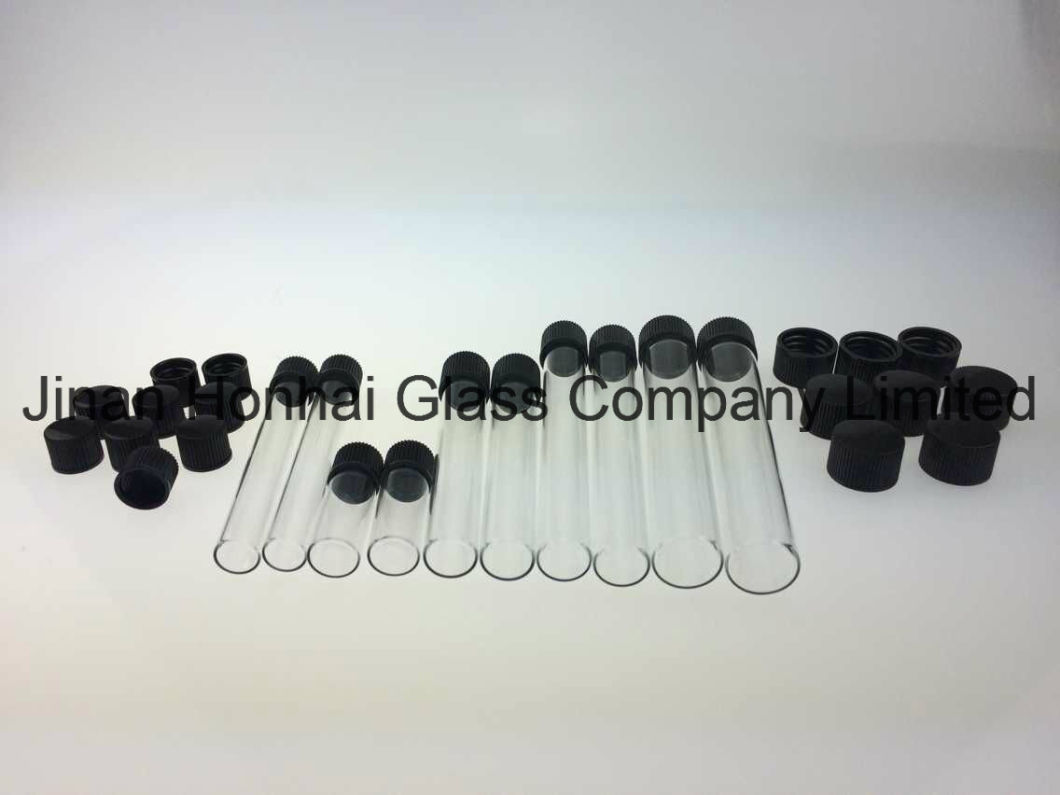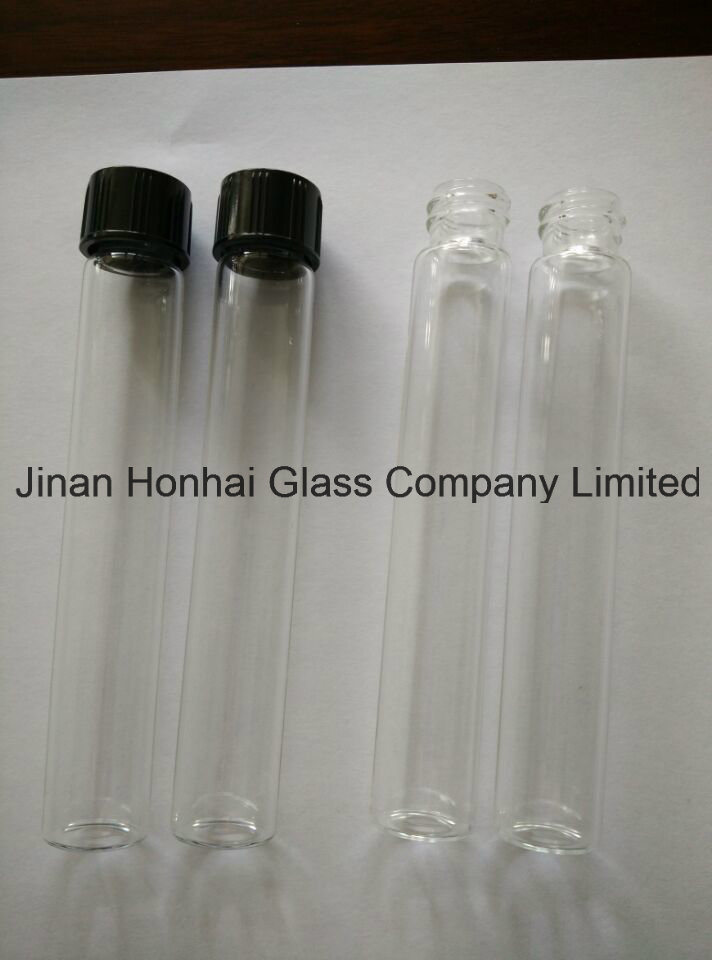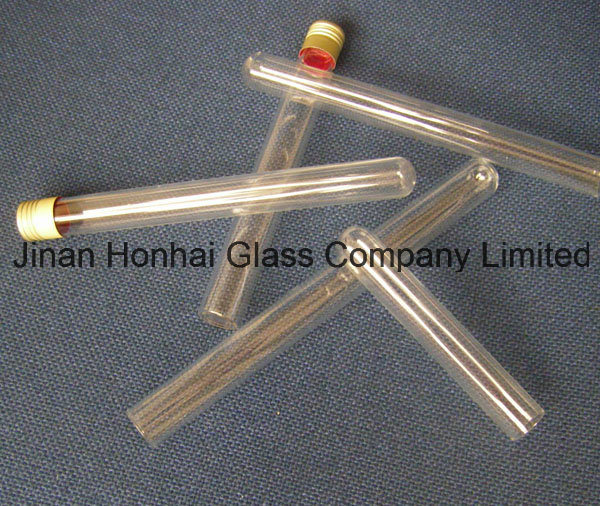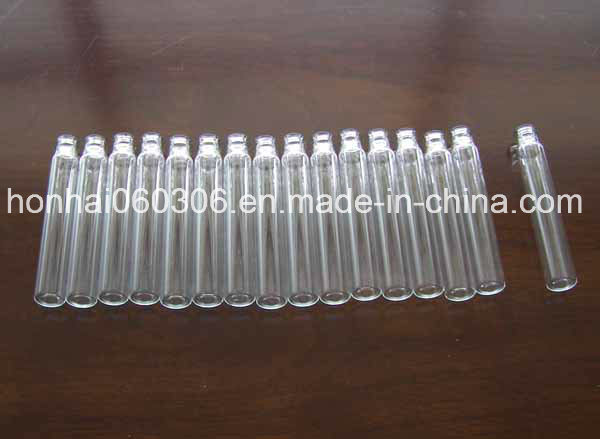Clear Glass Scew Neck Test Tube with Aluminum Cap
 A test tube, also known as a culture tube or sample tube, is a common piece of laboratory glassware consisting of a finger-like length of glass or clear plastic tubing, open at the top, usually with a rounded U-shaped bottom.
A large test tube specifically for boiling liquids is called a boiling tube.
Test tubes are available in a multitude of lengths and widths, typically from 10 to 20 mm wide and 50 to 200 mm long.[1] The top often features a flared lip to aid pouring out the contents; some sources consider that the presence of a lip is what distinguishes a test tube from a culture tube.[2] A test tube has either a flat bottom, a round bottom, or a conical bottom. Some test tubes are made to accept a ground glass stopper or a screw cap. They are often provided with a small ground glass or white glaze area near the top for labelling with a pencil.
Application:
Test tubes are widely used by chemists to hold, mix, or heat small quantities of solid or liquid chemicals, especially for qualitative experiments and assays. Their round bottom and straight sides minimize mass loss when pouring, make them easier to clean, and allow convenient monitoring of the contents. The long, narrow neck slows down the spreading of vapours and gases to the environment.
A test tube filled with water and upturned into a water-filled beaker is often used to capture gases, e.g. in electrolysis demonstrations.
Culture tubes are often used in biology for handling and culturing all kinds of live organisms, such as molds, bacteria, seedlings, plant cuttings, etc.; and in medicine and forensics to store samples of blood or other fluids.
A test tube with a stopper is often used for temporary storage of chemical or biological samples.
Test tubes are usually held in special-purpose racks, clamps, or tongs. Some racks for culture tubes are designed to hold the tubes in a nearly horizontal position, so as to maximize the surface of the culture medium inside.
Test tubes are sometimes put to casual uses outside of lab environments, e.g. as flower vases, glassware for certain weak shots, or containers for spices.
Where large numbers of tests are run or only small amounts are available for testing, or both, microtiter plates are often used as small test tubes.
Â
Manufacture:
Test tubes for physics and chemistry are usually made of glass for better resistance to heat and corrosive chemicals and longer life. Tubes made from expansion-resistant glasses, such as borosilicate glass, can be placed directly over a Bunsen burner flame.
Culture tubes for biology are usually made of clear plastic (such as polystyrene or polypropylene) by injection molding [3] and are often discarded after use.
Test tubes may come with prepared contents. For example, a blue top tube is a test tube of 5 ml containing sodium citrate as an anticoagulant, used to collect specimens for coagulation screens and testing for glucose-6-phosphate dehydrogenase.[4] A test tube is very resistant and can usually withstand temperatures over 300 degrees C.
(From Wiki pedia: http://en.wikipedia.org/wiki/Test_tube)
Â
Test tube:
Product description:
We can produce any sizes according to request.
Material: Neutral glass tube or borosilicate 3.3 glass tube.
We can print logo and text on all type of test tube.
Standard: ISO and YBB.
Yearly output: 200 million.
Normal sizes: (Outside Diameter*Length)
6*50mm
8*50mm
10*75mm
12*75mm
13*100mm
15*100mm
15*125mm
15*150mm
16*100mm
16*125mm
16*150mm
18*150mm





 clear glass scew neck test tube with aluminum cap
clear glass scew neck test tube with aluminum cap A test tube, also known as a culture tube or sample tube, is a common piece of laboratory glassware consisting of a finger-like length of glass or clear plastic tubing, open at the top, usually with a rounded U-shaped bottom.
A large test tube specifically for boiling liquids is called a boiling tube.
Test tubes are available in a multitude of lengths and widths, typically from 10 to 20 mm wide and 50 to 200 mm long.[1] The top often features a flared lip to aid pouring out the contents; some sources consider that the presence of a lip is what distinguishes a test tube from a culture tube.[2] A test tube has either a flat bottom, a round bottom, or a conical bottom. Some test tubes are made to accept a ground glass stopper or a screw cap. They are often provided with a small ground glass or white glaze area near the top for labelling with a pencil.
Application:
Test tubes are widely used by chemists to hold, mix, or heat small quantities of solid or liquid chemicals, especially for qualitative experiments and assays. Their round bottom and straight sides minimize mass loss when pouring, make them easier to clean, and allow convenient monitoring of the contents. The long, narrow neck slows down the spreading of vapours and gases to the environment.
A test tube filled with water and upturned into a water-filled beaker is often used to capture gases, e.g. in electrolysis demonstrations.
Culture tubes are often used in biology for handling and culturing all kinds of live organisms, such as molds, bacteria, seedlings, plant cuttings, etc.; and in medicine and forensics to store samples of blood or other fluids.
A test tube with a stopper is often used for temporary storage of chemical or biological samples.
Test tubes are usually held in special-purpose racks, clamps, or tongs. Some racks for culture tubes are designed to hold the tubes in a nearly horizontal position, so as to maximize the surface of the culture medium inside.
Test tubes are sometimes put to casual uses outside of lab environments, e.g. as flower vases, glassware for certain weak shots, or containers for spices.
Where large numbers of tests are run or only small amounts are available for testing, or both, microtiter plates are often used as small test tubes.
Â
Manufacture:
Test tubes for physics and chemistry are usually made of glass for better resistance to heat and corrosive chemicals and longer life. Tubes made from expansion-resistant glasses, such as borosilicate glass, can be placed directly over a Bunsen burner flame.
Culture tubes for biology are usually made of clear plastic (such as polystyrene or polypropylene) by injection molding [3] and are often discarded after use.
Test tubes may come with prepared contents. For example, a blue top tube is a test tube of 5 ml containing sodium citrate as an anticoagulant, used to collect specimens for coagulation screens and testing for glucose-6-phosphate dehydrogenase.[4] A test tube is very resistant and can usually withstand temperatures over 300 degrees C.
(From Wiki pedia: http://en.wikipedia.org/wiki/Test_tube)
Â
Test tube:
Product description:
We can produce any sizes according to request.
Material: Neutral glass tube or borosilicate 3.3 glass tube.
We can print logo and text on all type of test tube.
Standard: ISO and YBB.
Yearly output: 200 million.
Normal sizes: (Outside Diameter*Length)
6*50mm
8*50mm
10*75mm
12*75mm
13*100mm
15*100mm
15*125mm
15*150mm
16*100mm
16*125mm
16*150mm
18*150mm






First of all, use a universal cleaner to clean the dirt on the glass, lacquer and metal sheets to give a new look to the used car. After removing the dirt, the car owner needs to wax and polish the car body to keep the appearance of the used car bright and tidy. If the car owner himself does not know how to do this, he can also find a professional car wash shop to handle it.
In addition, some details of the car body should be handled carefully. The appearance details such as used car rims, bumpers, fenders, spoilers, plastic decorative panels, exhaust pipes, etc. need to be treated with various protectors to prevent dirt residues from affecting these parts.
In terms of interior decoration, plastic and rubber parts such as the instrument panel, door wing, and gear area should be cleaned with a special cleaning fluid. The cleaning fluid is evenly sprayed on the instrument panel or the plastic part to clean and prevent the plastic from cracking and fading. And leave a quiet fragrance, in addition to static electricity, so that dust is not easy to adhere. The air outlet of the air conditioner should be thoroughly cleaned with a fine-bristle brush to prevent stains from remaining and hinder the normal operation of the air conditioner. All plastic, rubber and other parts should be coated with light protection wax to prevent the instrument panel and other parts from becoming white and cracked due to excessive obsolescence or direct sunlight.
For car ceilings, carpets and other flannel parts, use a neutral cleaning fluid to scrub. If the cleaning fluid is too alkaline, it will cause the fluff to become stiff and affect the appearance. This cleaning agent can also be used to clean the trunk.
Other parts of the car, such as leather seats or flannel seats, must be cleaned with different components of detergent to maintain the original texture. Second-hand car leather seats need to use special leather care spray wax, which forms a protective film on the leather surface, which can be waterproof and antifouling; flannel seats should use a special velvet decontamination spray, which can clean dirt deep into the fiber and make it The color restores its brilliance as new.
In addition to the appearance and interior of second-hand car refurbishment, parts such as engines and wheels also need to be cleaned. How should these parts be refurbished? Car owners and friends can use special cleaning agents to clean the dirt on the exterior of the engine, carburetor, water tank, and wheel hub to improve the performance of the used car engine system.
Used Dump Trucks,Used Tractor Trucks,Used Special Purpose Trucks
Zhengzhou Dongfeng Mid-south Enterprise Co., Ltd. , https://www.cn-dfmtruck.com
